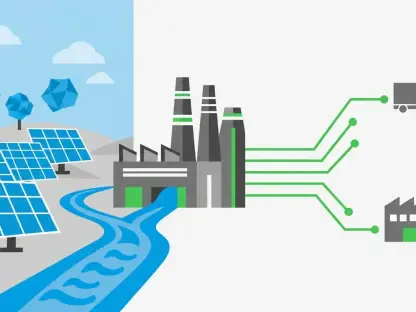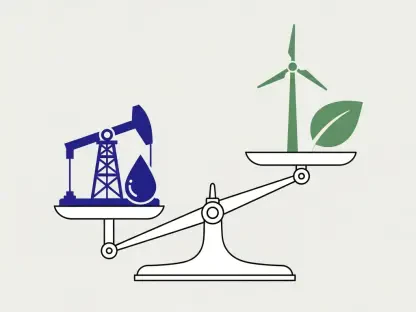In late 2024, Germany faced an unprecedented energy challenge as wholesale electricity prices skyrocketed above 300 euros per megawatt hour during early November and mid-December, dwarfing the yearly average of 79 euros. This dramatic spike, occurring in a nation already navigating a post-nuclear energy landscape after closing its last plant in 2023, raised urgent questions about market fairness and grid reliability. With public trust wavering and regulatory scrutiny intensifying, this roundup dives into diverse perspectives from industry analysts, policymakers, and energy experts to unpack whether German firms manipulated these surges or if deeper systemic flaws are at play. The goal is to synthesize varying opinions and offer a clearer picture of this critical issue.
Unraveling the Causes Behind the Price Spikes
Market Manipulation or Genuine Shortfall?
A joint investigation by German authorities found no concrete evidence of market abuse by the country’s largest electricity producers during the 2024 price surges. Many industry observers agree with this assessment, noting that nearly all available generation capacities were deployed during the crisis periods. This perspective suggests that the high prices reflected real supply constraints rather than deliberate withholding by firms to inflate costs.
However, not all voices align with this conclusion. A segment of consumer advocacy groups remains skeptical, arguing that the lack of transparency in energy trading practices leaves room for undetected profiteering. These critics point out that while overt manipulation may not have been proven, subtle strategic behaviors by companies could still have influenced market dynamics during peak demand.
Further complicating the debate, some market analysts highlight that the investigation’s scope might have missed smaller players or indirect tactics. They suggest that future probes should incorporate broader data on trading patterns and contractual agreements to fully rule out any exploitative practices. This divergence in opinion underscores a lingering tension between regulatory findings and public perception.
The Impact of Weather on Renewable Energy
Another widely discussed factor in the price surge is the phenomenon of “Dunkelflaute”—periods of dark, windless weather that severely limited solar and wind power output in late 2024. Energy researchers emphasize that with renewables accounting for 57% of Germany’s power mix in that year, such weather events exposed critical vulnerabilities. The consensus here is that these natural conditions directly contributed to the supply shortages driving price spikes.
On the flip side, some environmental advocates argue that while Dunkelflaute events are challenging, they should not derail Germany’s renewable ambitions. They propose that the focus should shift toward enhancing energy storage solutions and grid interconnectivity to mitigate such shortfalls. This viewpoint pushes for innovation rather than a retreat to traditional energy sources as a quick fix.
A third angle comes from grid operators who stress the unpredictability of weather-dependent energy sources. Their insights reveal a pressing need for advanced forecasting tools and real-time demand management systems to better prepare for sudden drops in renewable output. This technical perspective adds a layer of practicality to the broader discussion on sustainability versus stability.
Systemic Challenges in a Post-Nuclear Energy Landscape
Infrastructure Deficits and Backup Gaps
Germany’s decision to phase out nuclear power by 2023 left the nation with fewer reliable backup options during the 2024 crisis, a point echoed by many infrastructure experts. They argue that the absence of steady baseload power exacerbated price volatility, especially during periods when renewables faltered. This gap in capacity is seen as a structural flaw that demands urgent attention.
Differing opinions emerge on how to address this deficit. Some policy analysts advocate for accelerating the development of gas-fired plants through government auctions under EU state aid frameworks, viewing them as a necessary bridge to stabilize the grid. They believe this approach can provide immediate relief while maintaining a path toward long-term decarbonization goals.
Others, including certain renewable energy proponents, caution against over-investing in fossil fuel infrastructure. Their stance is that such moves could lock Germany into carbon-intensive systems for decades, undermining climate commitments. Instead, they urge greater investment in alternative backups like hydrogen-based technologies, even if these solutions require more time to scale.
Strategies for Energy Security
Insights from regulatory bodies and strategic planners focus on the need for new power station capacity to prevent future crises. Many in this circle support decentralizing thermal capacity through competitive auctions, which could reduce market concentration among major players. This idea is seen as a way to foster resilience and fairness in the energy sector.
A contrasting viewpoint from demand-side management experts emphasizes flexible consumption models over simply building more plants. They suggest incentivizing industries and households to adjust usage during peak loads, using smart grid technologies to balance supply and demand dynamically. This innovative approach aims to address shortages without heavy reliance on new infrastructure.
Additionally, some economic advisors propose a hybrid strategy that combines infrastructure expansion with demand flexibility. Their reasoning is that a balanced energy framework must tackle both supply-side reliability and consumer behavior to create a robust system. This comprehensive outlook seeks to integrate multiple solutions for maximum impact.
Key Takeaways from Diverse Perspectives
The 2024 power price investigation in Germany revealed a complex web of challenges, with expert opinions converging on the absence of clear market manipulation by major firms. Most agreed that supply shortages, driven by weather-related renewable shortfalls and infrastructure gaps, were the primary culprits. However, debates persist over the adequacy of current investigative methods and the transparency of market operations.
Differing views on solutions highlight a spectrum of priorities. While some push for rapid deployment of gas plants as a practical fix, others advocate for long-term investments in storage and alternative technologies to align with sustainability goals. Meanwhile, ideas around demand management and grid modernization offer forward-thinking alternatives to traditional capacity expansion.
A notable point of consensus is the fragility of Germany’s energy framework in its current state. Experts across the board stress that reliance on renewables, while commendable, requires robust backup systems to handle inevitable fluctuations. This shared concern forms a foundation for ongoing policy discussions and potential reforms.
Reflecting on the Path Forward
Looking back, the discourse surrounding the 2024 German power price surges clarified that systemic vulnerabilities, not corporate misconduct, drove the crisis. The range of expert insights gathered underscored a pivotal moment for the nation’s energy transition, highlighting both achievements and shortcomings. It became evident that no single solution could address every facet of the challenge.
Moving forward, stakeholders should prioritize a multifaceted strategy that includes supporting gas plant auctions for immediate stability, investing in cutting-edge storage solutions for sustainable growth, and implementing smart grid technologies for demand flexibility. Staying informed about upcoming government initiatives, such as capacity auctions planned from 2025 onward, will be crucial for industry players and consumers alike. This balanced approach promises to fortify Germany’s grid against future shocks while preserving its commitment to a greener future.









